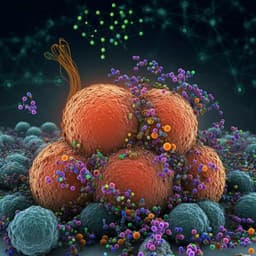Introduction
Protein post-translational modifications (PTMs) are crucial for cellular signal transduction, enabling cells to adapt to various stimuli. Dysregulation of PTMs can lead to diseases like cancer. Lysine crotonylation (Kcr), a recently discovered PTM, is involved in transcription regulation, cell signaling, and other processes. While several crotonylases and decrotonylases of histones have been identified, the regulation of non-histone protein crotonylation remains largely unclear. Hypoxia, a common feature of solid tumors, alters cellular behavior by modifying metabolic pathways, promoting angiogenesis, and influencing other processes. This study investigated the role of hypoxia in regulating protein crotonylation in liver cancer, hypothesizing that hypoxia induces crotonylation, contributing to liver cancer cell growth. The researchers aimed to identify hypoxia-regulated Kcr proteins and investigate the functional significance of a specific Kcr modification. The study's importance lies in its potential to reveal novel therapeutic targets for liver cancer.
Literature Review
Previous research established the involvement of crotonylation in various cellular processes, including DNA damage repair, stem cell differentiation, and HIV latency. Several enzymes have been identified as possessing crotonyltransferase or decrotonylase activity, including p300/CBP, MOF, PCAF, HDACs, and SIRTs. However, the precise mechanisms and functional roles of crotonylation in different biological contexts, especially in cancer, needed further clarification. Studies have also linked hypoxia to changes in protein degradation, protein-protein interactions, and RNA processing in liver cancer, yet the connection to crotonylation remained unexplored. This paper built upon previous research by focusing on a comprehensive analysis of the crotonylome in liver cancer tissue under hypoxic conditions, aiming to identify key regulatory players and elucidate functional roles in cancer progression.
Methodology
The study employed a multi-faceted approach. First, Western blotting was used to assess crotonylation levels in liver cancer tissues and cell lines under various conditions (hypoxia, glucose starvation, ethanol exposure). Cell lines (PLC/PRF/5, HepG2, Huh7, SK-Hep1) were treated with sodium crotonate (NaCr) to investigate the effects of crotonylation on cell growth using CCK-8 assays and in vivo tumor growth assays in nude mice. To obtain a global view of crotonylation, TMT-labeled LC-MS/MS lysine crotonylome analysis was performed on 12 pairs of hepatocellular carcinoma and adjacent liver tissues. Immunoprecipitation (IP)-MS proteomics identified crotonylated proteins in hypoxic and normoxic PLC/PRF/5 cells. Molecular cloning, plasmid transfection, RNA interference, CRISPR/Cas9 knockout, and immunofluorescence assays were utilized to investigate the role of specific proteins, particularly lamin A. The effects of HDAC inhibitors and histone acetyltransferase inhibitors were assessed to identify potential decrotonylases. Statistical analyses, including Student's t-tests, were used to evaluate the significance of the findings.
Key Findings
The study revealed a significant upregulation of Kcr in liver cancer tissues compared to adjacent normal tissues. NaCr treatment increased Kcr levels and promoted liver cancer cell growth in vitro and in vivo. Hypoxia was identified as a key inducer of crotonylation. Quantitative proteomics identified 3,793 crotonylation sites on 1,428 proteins. Lamin A was identified as a key target, with crotonylation at K265/270 sites promoting cell proliferation and preventing senescence. HDAC6 was found to be the decrotonylase of lamin A, with its downregulation under hypoxia leading to increased lamin A crotonylation. Knockout of LMNA attenuated the tumor growth-promoting effect of NaCr. The K265/270R mutant of lamin A decreased cell growth and increased senescence-related markers (SA-β-Gal, p21, p16, IL-6, IL-8). Overexpression of HDAC6 reduced lamin A crotonylation and diminished the growth-promoting effect of lamin A.
Discussion
The findings of this study provide strong evidence for the role of hypoxia-mediated lamin A crotonylation in liver cancer progression. The identification of HDAC6 as the lamin A decrotonylase offers a potential therapeutic target. The study's impact extends beyond its specific findings by highlighting the importance of studying non-histone protein crotonylation in cancer biology. The observed correlation between hypoxia, HDAC6 downregulation, and increased lamin A crotonylation suggests a novel mechanism contributing to liver cancer growth and the evasion of cellular senescence. Future studies should focus on exploring the precise mechanisms by which lamin A crotonylation regulates downstream targets like p21 and p16, and investigation into potential crotonylases of lamin A.
Conclusion
This research demonstrates a significant upregulation of protein crotonylation in hypoxic liver cancer, driven by hypoxia-mediated downregulation of HDAC6 and subsequent increased lamin A crotonylation at K265/270. This modification promotes cell proliferation and inhibits senescence, thus advancing liver cancer progression. The identification of HDAC6 as a key regulator presents a promising avenue for therapeutic intervention. Future research should focus on identifying the crotonylases involved and investigating the precise molecular pathways by which lamin A crotonylation influences cell cycle regulation and senescence.
Limitations
The study primarily focused on in vitro and in vivo experiments using specific cell lines and mouse models. The generalizability of these findings to all types of liver cancer or other cancer types requires further investigation. While HDAC6 was identified as a decrotonylase for lamin A, the specific crotonylases responsible for lamin A crotonylation remain to be identified. Further research using more diverse clinical samples and more extensive validation studies would strengthen the conclusions of this study.
Related Publications
Explore these studies to deepen your understanding of the subject.






